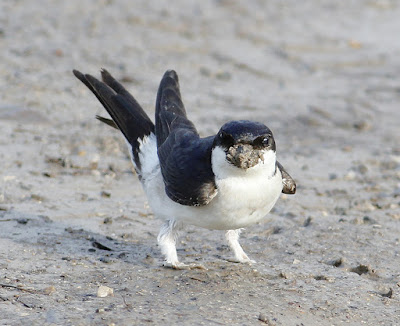Just lately my local patch has become rather crowded as folk arrive at Conder Green targeting the ever elusive Spoonbill and looking for the more recent Lesser Yellowlegs. Even the Yellow Wagtails of Cockerham Marsh have received attention from folk who no longer see the species, so rare has it become.
I also saw a couple of twitchers at Fluke Hall, maybe looking for Green Sandpipers but surely not Tree Sparrows? One never knows for sure these days when bird watching is learnt back to front, the rarest first and the most common species last.
Yellow Wagtail
With a brief lull in the wind I decided to head for the hills of Oakenclough for a spot of ringing. I managed three hours before the wind arrived again, this time bringing heavy showers prompting an early finish.
An interesting session saw me catch 20 birds of 7 species, one of which was a species I’d not handled for almost 30 years, the last time in 1988.
The numbers were 5 Chaffinch, 5 Goldcrest, 3 Coal Tit, 2 Blue Tit, 2 Lesser Redpoll, 2 Chiffchaff and 1 Bullfinch.
The Fylde Ringing Group has ringed only 23 (now 24) Bullfinch in its 30 years of existence. It was in 1988 that I last ringed a Bullfinch at Winmarleigh Hall, a year or two before that lovely old woodland was sold to developers to create an “educational adventure playground”.
Yes the Bullfinch is a rarity on the coast where I live, becomes more marginally common inland but is never widespread and certainly never ever numerous. Today’s Bullfinch was a recently fledged juvenile, a "3J", and with being so late in the month of August, probably from a second brood.
Bullfinch
Bullfinch
The first year Lesser Redpoll below is in the process of renewing its centre tail feathers, the newer ones destined to be a rounder shape and of different colouration to the outermost pointed and now worn ones of birth.
Lesser Redpoll
Meanwhile an adult male Lesser Redpoll is renewing its flight feathers, the older and slightly bleached outer primaries markedly different to those feathers which are both new and still growing. Many birds are rather scruffy at the time of year when they are in various stages of moult.
Lesser Redpoll
Lesser Redpoll
The adult’s tail feathers are new, fresh and rounded in comparison to the pointed tail feathers of a first year bird. The characteristic of tail shapes is very common in finches and other bird families but there are exceptions designed to trap the unwary.
Lesser Redpoll
Chaffinch
Birding in between the ringing saw 140+ Swallows, 2 Grey Wagtail, 2 Pied Wagtail, 1 Nuthatch, 1 Great-spotted Woodpecker, 15+ Siskin and 1 Buzzard.
The current weather forecast doesn’t improve much so I may not escape to anywhere at the weekend. If I do, read about it here on Another Bird Blog.
Linking today to I'd Rather Be Birding and Eileen's Saturday Blog.
Linking today to I'd Rather Be Birding and Eileen's Saturday Blog.

































































.jpg)












